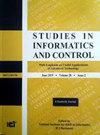基于微服务架构的机器学习算法水平调优框架
IF 1.1
4区 计算机科学
Q4 AUTOMATION & CONTROL SYSTEMS
引用次数: 0
摘要
本文章由计算机程序翻译,如有差异,请以英文原文为准。
A Horizontal Tuning Framework for Machine Learning Algorithms Using a Microservice-based Architecture
: Usually, data collected through surveys or by means of sensors is prone to errors and inaccuracies, such as missing data and outliers. Such datasets consist of numerical and string variables, with a high variety of values. Emerging issues, for instance, missing or categorical data lead to errors in running most of the machine learning algorithms. Data analysis and pre-processing are usually more substantial and time-consuming than the implementation of the machine algorithms. Nevertheless, the obtained results are significantly influenced by the way missing data or outliers are approached. This paper presents various methods for coping with null and extreme values. Furthermore, it highlights the significance of encoding and scaling the analysed data and their impact on the performance of the machine learning algorithms. Thus, this paper proposes a methodology for a Missing, Outliers, Encoding & Scaling (MOES) horizontal tuning framework using microservices as applications for data processing in order to obtain the best combination of the employed methods. For exemplification purposes, a real data set from the banking sector is used. Furthermore, the proposed methodology was tested using a second real data set from the utilities sector and the results also showed that both the AUC (Area under the Curve) and execution time were better than in the case of employing the PyCaret Python library.
求助全文
通过发布文献求助,成功后即可免费获取论文全文。
去求助
来源期刊

Studies in Informatics and Control
AUTOMATION & CONTROL SYSTEMS-OPERATIONS RESEARCH & MANAGEMENT SCIENCE
CiteScore
2.70
自引率
25.00%
发文量
34
审稿时长
>12 weeks
期刊介绍:
Studies in Informatics and Control journal provides important perspectives on topics relevant to Information Technology, with an emphasis on useful applications in the most important areas of IT.
This journal is aimed at advanced practitioners and researchers in the field of IT and welcomes original contributions from scholars and professionals worldwide.
SIC is published both in print and online by the National Institute for R&D in Informatics, ICI Bucharest. Abstracts, full text and graphics of all articles in the online version of SIC are identical to the print version of the Journal.
 求助内容:
求助内容: 应助结果提醒方式:
应助结果提醒方式:


